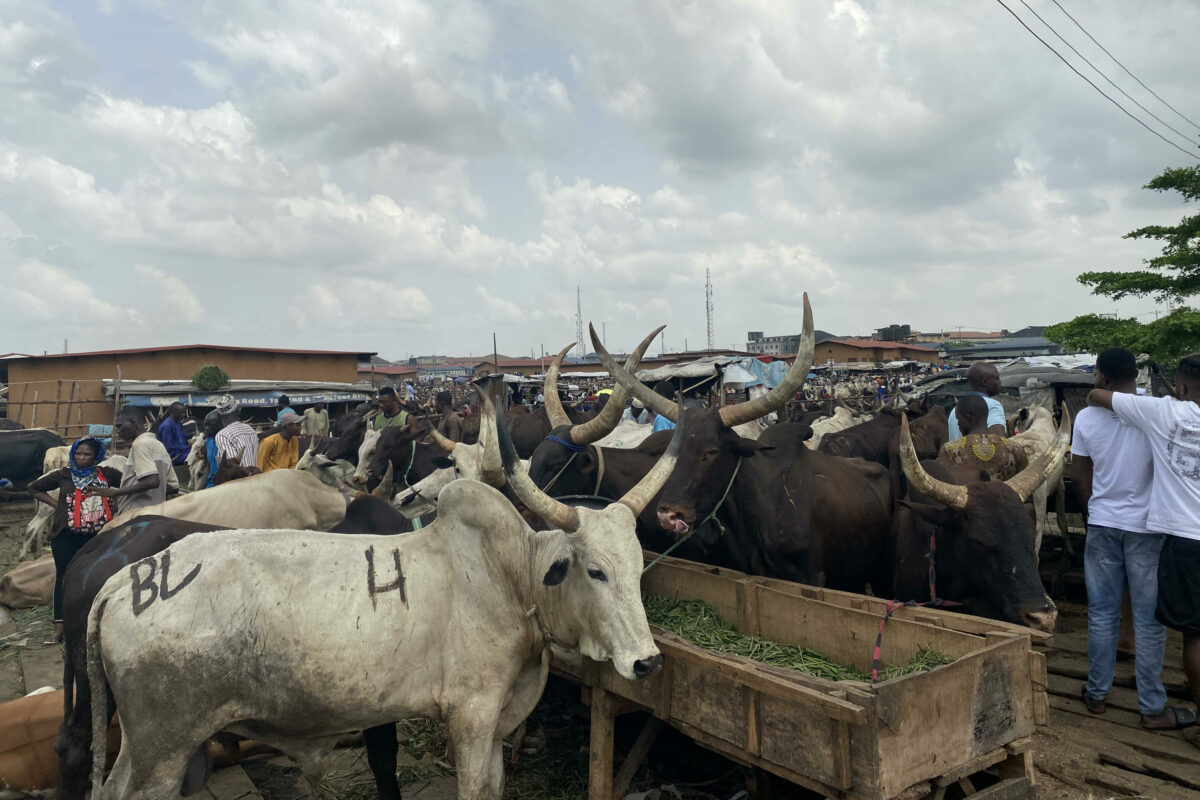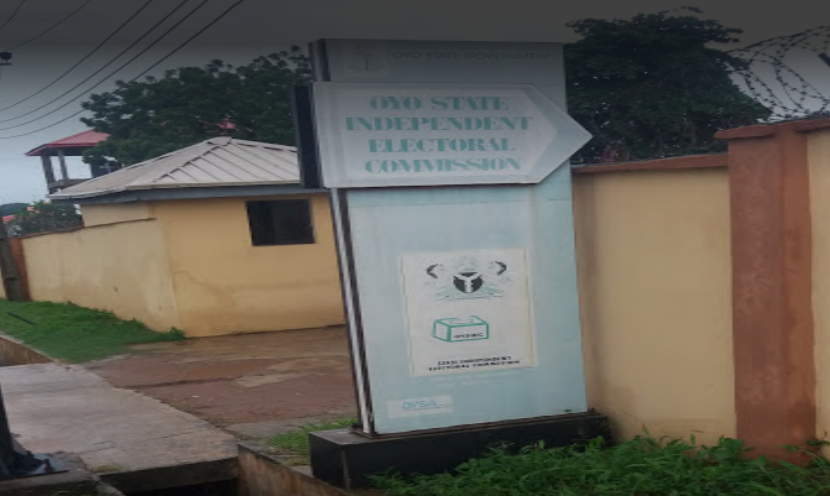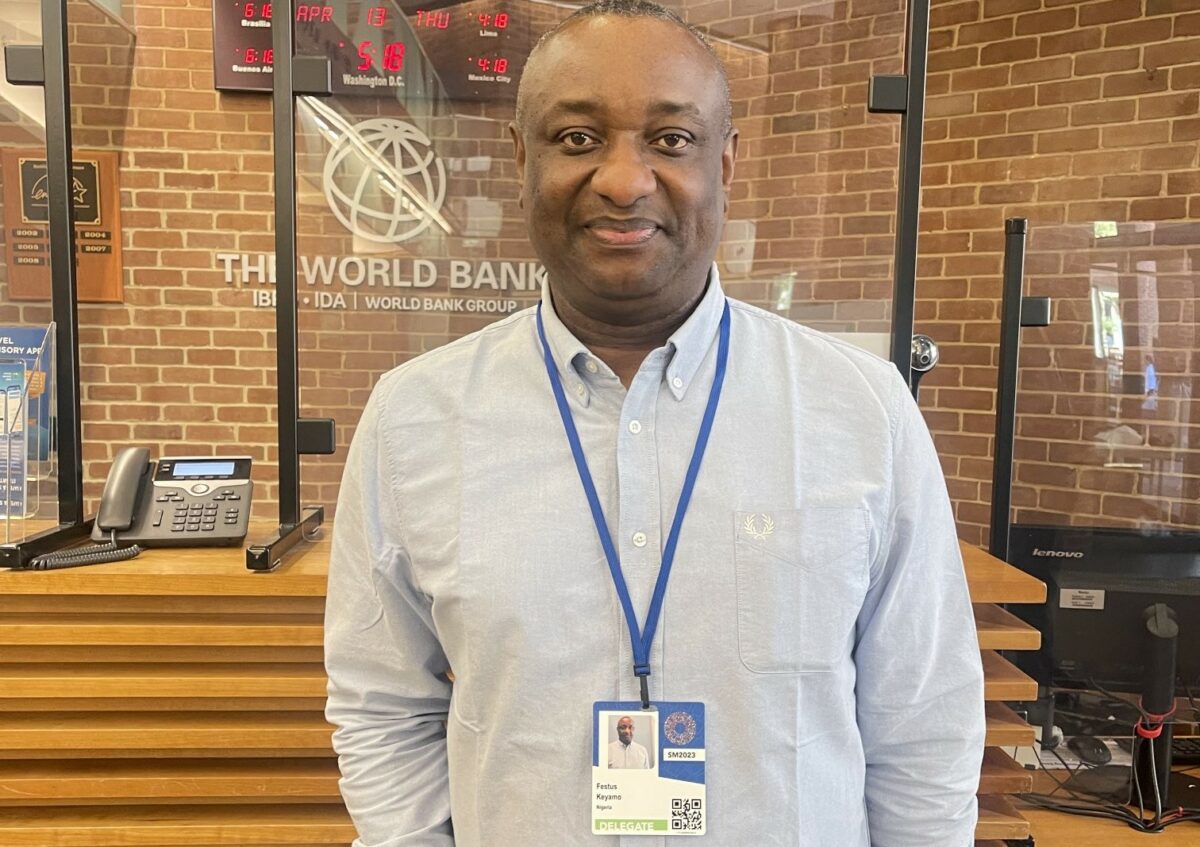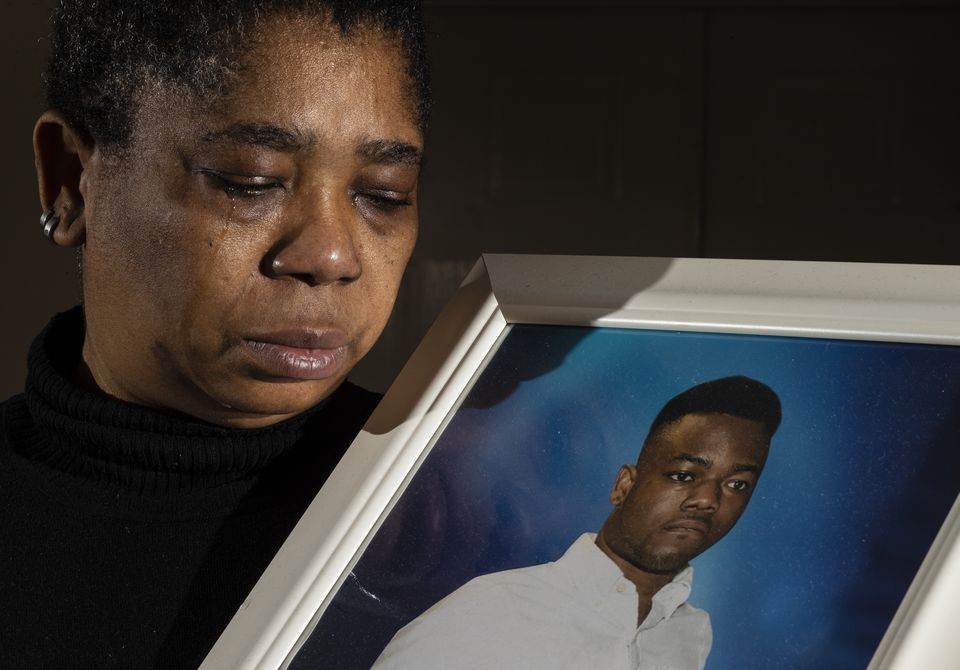The Oko-Oba Abattoir in Lagos stands as a bustling hub for meat processing as it supplies the city with a significant portion of its daily consumption. But what is concealed beneath this establishment is a grim reality – animals unfit for consumption are finding their way into the market, and this is contrary to the mission statement of the state ministry of agriculture. In this investigative piece, FIJ’s EMMANUEL UTI exposes the anomalies present in Lagos’ biggest slaughterhouse.
When an acquaintance hinted at potential shadiness within the confines of the Oko-Oba slaughterhouse, he spoke in parables. But a gentle nudge from this reporter would later prompt him to explain some of the unsettling details he alluded to, which ultimately became my reason for visiting the slaughterhouse.
Among the many revelations, the one that stuck with me the most was the repulsive process of killing and selling to the unwary public for consumption; even more upsetting, he said, was how dead animals are butchered in the slaughterhouse, with everyone there ignoring the unethical practice. Curious to see if these claims were accurate or merely an exaggeration based on a single incident, I decided to keep a watch on the renowned slaughterhouse.
I had to wait another week for my resolution to come to pass, and when it did, I ended up going back a second and third time, the first time for confirmation and the third time because I needed to be convinced.
ENTERING THE SLAUGHTERHOUSE
My first visit to the slaughterhouse was on Friday, November 3. When I got to the bus stop of the slaughterhouse, I saw a teeming throng of individuals trooping in and out of the gate, flanked by traders and small-scale butchers lining the two sides of the road. Just before I could enter the compound, a young, rugged-looking fellow darted towards me and presented me with a N50 ticket. I asked him what the ticket was for and why I needed it. He explained that this ticket was my golden key to the slaughterhouse and a necessary toll for its upkeep. Without further ado, I paid him, got the ticket and entered the compound.
Immediately after I got into the compound, it felt like another world. Men and women were carrying basins of blood-dripping fresh animal parts in large chunks on their heads and were heading outside. Some tiny goats were roaming freely, and a multitude of umbrella shades harboured traders selling an eclectic array of items. In one of the lairages close to the gate, humans were there as though they shared the place with the cows. Clothes lay strewn in the lairage, and some men lounged on mats. By the side of the lairage were heaps of animal dung with an extremely offensive smell, the likes of which you’re fortunate not to experience, but it seemed like the men had become inured to its odour.

Notably, there were white tricycles close to the gate that transported people to the market. Because the distance from the gate to the market is within an eye shot, I walked my way down there. And while I did, the squalor and noxious stench in the compound made me wonder what exactly the money realised from the N50 tickets issued daily is used for. In fact, the farther I ventured, the more pungent the smell and the deeper the hue of the blooded water in the gutters.
THE FIRST SLAB
I had not even entered the first slab’s domain that first day when a fair-skinned gentleman asked me what I wanted. When I answered in English, he quickly assumed that this was my first time visiting the compound, and he promised to make my stay easier. Since I was not ready to buy anything, I could not say much, so I suggested taking a tour of the compound to see what it looked like. He immediately accepted the idea and led me to the first slab, where he suggested I sit down while he took care of some business. The first slab was a sprawling elevated concrete platform that looked like the typical Nigerian public road with its share of potholes.
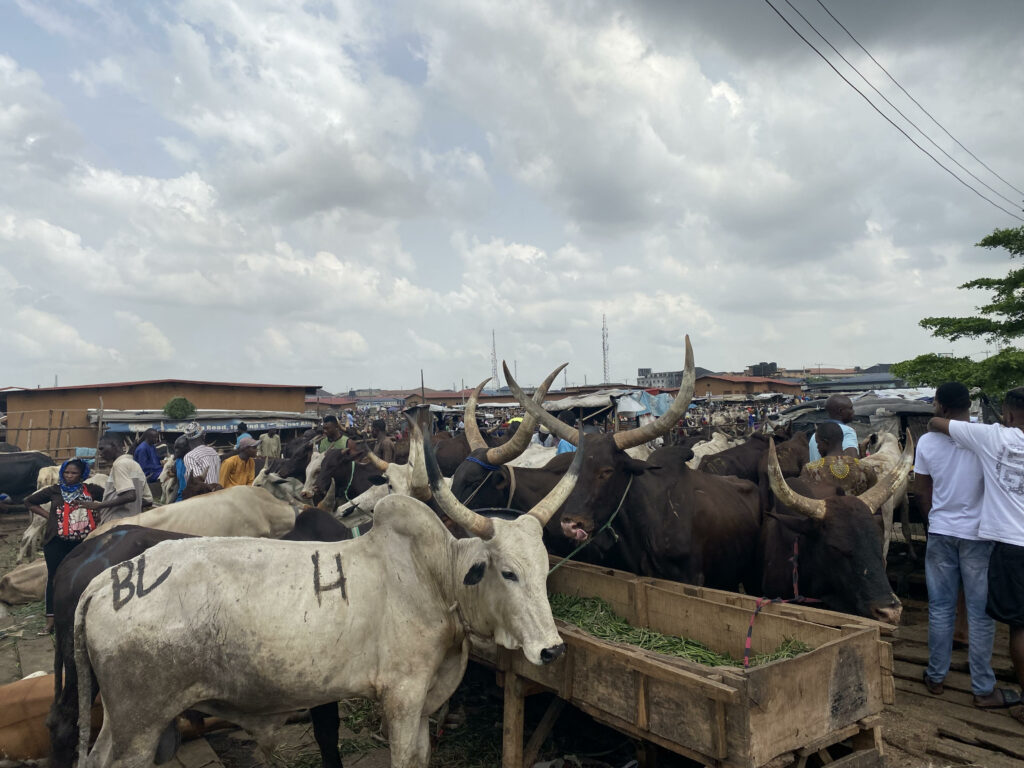
It was on this same slab that I saw so many cow legs and skin frequently referred to as ponmo. It did not take long for me to discern that the first slab was primarily used by members of the Cow Skin Leg Dealers Association, whose uniform is tinged with the burnt sienna colour. The first slab had a multitude of cow legs, a sight less crowded on all my visits than the second slab. But one factor was constant – it was unquestionably grimy. Coagulated blood had solidified on its surface; spilled blood formed different shapes which invited a buzzing swarm of flies; and a set of blue drums close to the slab were filled with the blood of cows. A short distance away, butchers beckoned to passersby seeking assistance in buying and cutting purchased meat into desired pieces. As I observed, these butchers skillfully resized heads and various cow parts bought by their customers into the desired pieces.

A LIE PROPERLY HIDDEN
After the butcher finished his shift, he came up to me and I asked him how I would go about buying a cow. Instead of answering right away, he asked me to go with him to Kara, which is the busy area where cow sales take place. On the way there, we walked through puddles that were now black from the constant traffic. Once we got inside Kara, I saw an amazing sight of healthy, robust cows. After I had fed my eyes, I told him I had to go home.
As I was leaving, I noticed a group of wooden carts parked behind a section reserved for cows near the entrance to Kara. A short while later, I saw a man tethering a dead cow to one of the carts and steering it away. When I asked where the cow was going, he said it was being taken for proper disposal, and he seemed to mean it. He seemed to have a lot to say even without being asked a lot of questions.
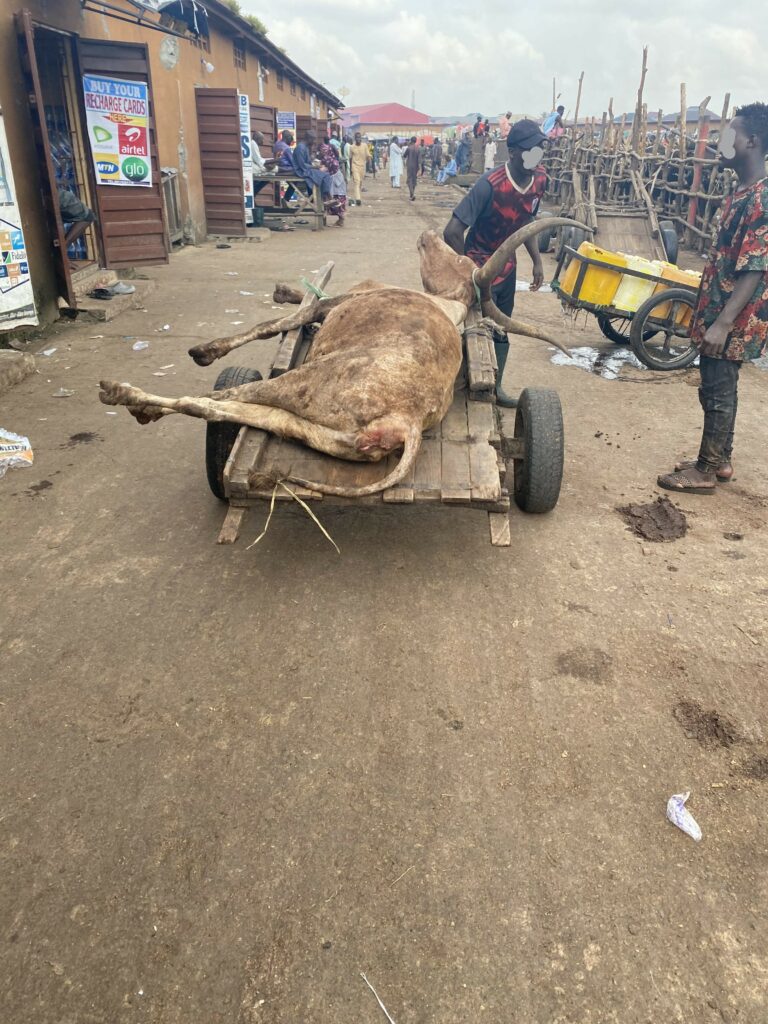
“In this compound, we do not slaughter or sell dead animals due to religious reasons – it’s considered haram. When a cow falls ill or succumbs, we ensure proper disposal to prevent contamination,” he told FIJ.
Curious, I asked him how cow owners would feel about this kind of fate, and he replied that they would be glad to put doing the right thing ahead of profiting from it. Then it was time to part, so I thanked him for his insights, took his number in case we needed to talk again, and said goodbye.
SHADY DEALS AT THE ABATTOIR
On Friday, November 17, I had my second encounter with the slaughterhouse. Upon entering, I noticed a number of people looking at me with a kind of awe, but I could not quite put my finger on why. Later, I realised that my attire matched that of the outside veterinary doctors who had examined the activities at the slab only four days earlier. Despite their questioning looks, I continued my search for information by heading straight to the second slab. Little did I know that I was about to enter the centre of the slaughterhouse’s most dubious and unethical practises.
READ ALSO: SPECIAL REPORT: Inside Oyo Communities Where Girls Abandon Schools to Milk Cows
Similar to the first slab, the second was plastered with animal dung and coagulated blood. But the malpractices there were more pronounced, and the people involved are brazen. Standing amidst the tumult, I witnessed men ushering in cows, some in apparent revolt against their impending doom, while others seemed resigned to their grim destiny. The cacophony of voices and the unharmonious sounds of machetes and knives wielded by the butchers showed how serious business on the slab is.
As I observed, young men rolled in lifeless cows on the familiar wooden carts I had seen on November 3. In a span of 10 minutes, at least 11 dead cows were wheeled in, each telling a tale of its own demise – wrinkles, dried skin, and darkened hues revealed that they died due to illnesses. What followed was a swift butchering of the animals.
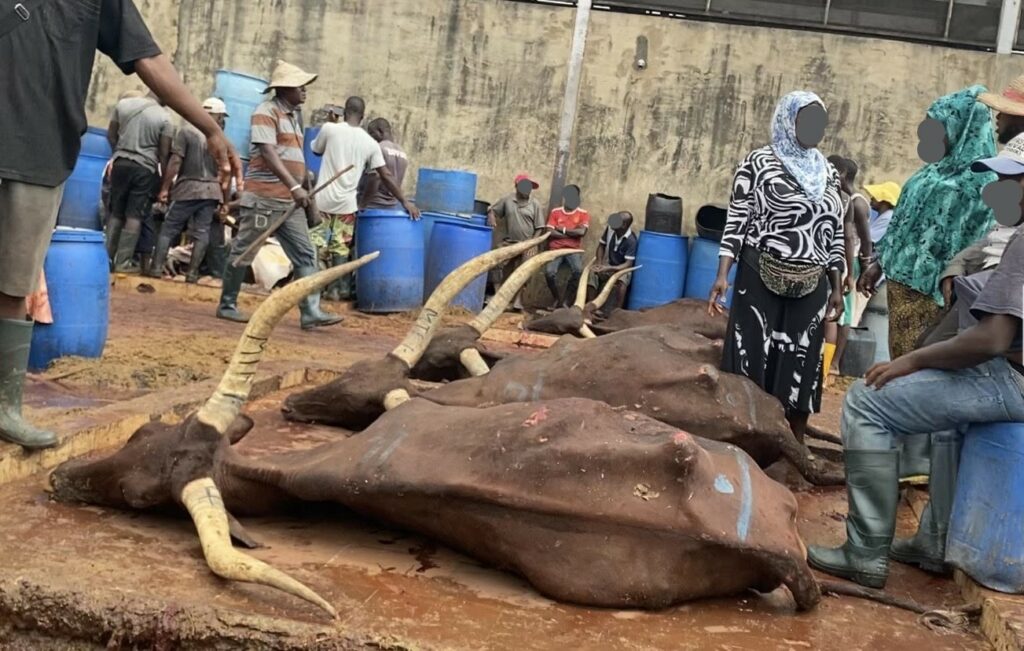
My attempt to trace the origins of these dead cows led me to a disconcerting revelation: sick cows, too, found their way to the slaughter. As I ventured towards the Kara section, I witnessed young men propelling ailing cows on wooden carts towards the slab. Pausing for a moment, I observed more men emerging from Kara with dead cows on carts. Instead of heading straight to the slab, they first went to a tap with running water, where they cleansed the lifeless forms before transporting them to the butchering site. This ritual contradicted the narrative spun by the first man I had spoken to. It then dawned on me that the first man lied.
MOTIVATED BY GREED
Once I had confirmed that dead and ailing animals were destined for the public’s plate, I went to the second slab to take pictures and videos. Upon arrival, a middle-aged woman, noticing the phone in my hand, cautioned against taking pictures. She said that the men in the slaughterhouse frowned at it. She said they think that people who attempt to take pictures or videos will present them to the government, who will then force them out of work. I ignored him and carried on till I came across a tall man with shaky legs.
Physically frail and evidently influenced by alcohol, the man asked me why I was in the slaughterhouse. Without hesitation, I spun a tale of wanting to purchase a dead cow for an upcoming anniversary and butchering it on the slab to make money off the church that sent me. The man then insisted that I follow him to a location where he could take more big gulps of alcohol before beginning the questionable task of obtaining a large but dead cow. Some 15 minutes after we arrived at the trader’s shelter, I knew I had to move on with my story, so I concocted a swift excuse, stating that the church had enlisted someone else for the job. Twisting my face in a simulated display of disgust and pain, I told him I was ready to go. But before I stood up to leave, I asked him about the ease with which dead cows and sick animals were processed for public consumption.
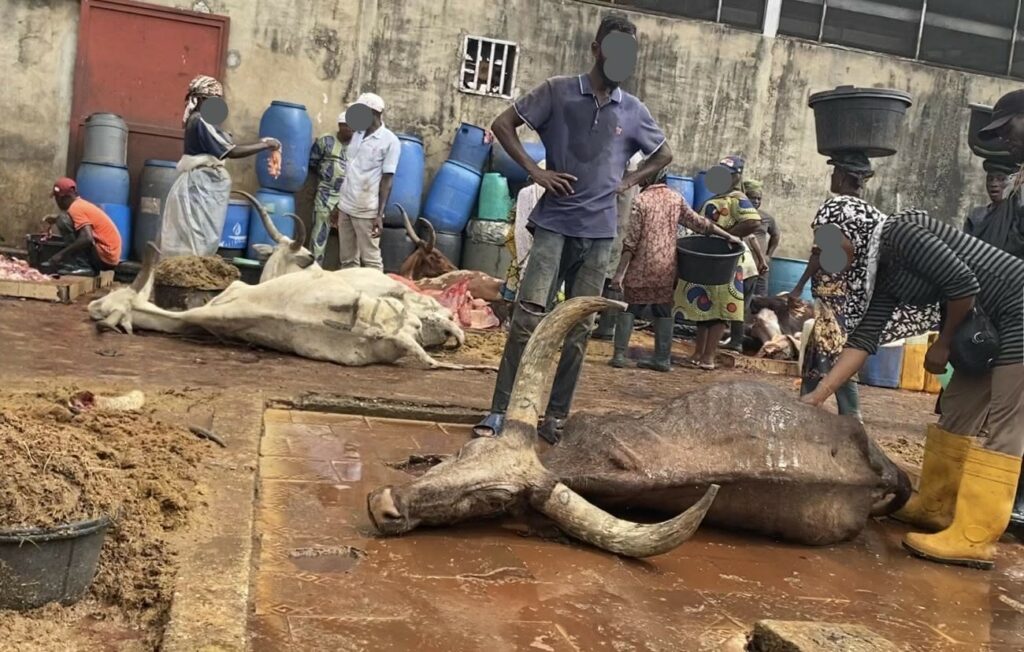
In response, he chuckled and offered a moment of unfiltered truth. “Who do you think would bear the loss of a dead cow in Nigeria, given the current circumstances?” Maintaining eye contact, he continued, “Business owners in this trade would suffer significant losses if they strictly adhered to the law. During the transportation of cows from places like Ilorin to Lagos, many animals become weak on the journey, so we have to slaughter them for sale before they die. If any perish during the process, the owners still have to sell them, as they cannot afford the loss,” he explained.
He further said that everything in the slaughterhouse is a coordinated business that people engage in to survive. He acknowledged that cattle owners should be following the standard procedure for doing things but many deviate due to a lack of incentives for playing by the rules.
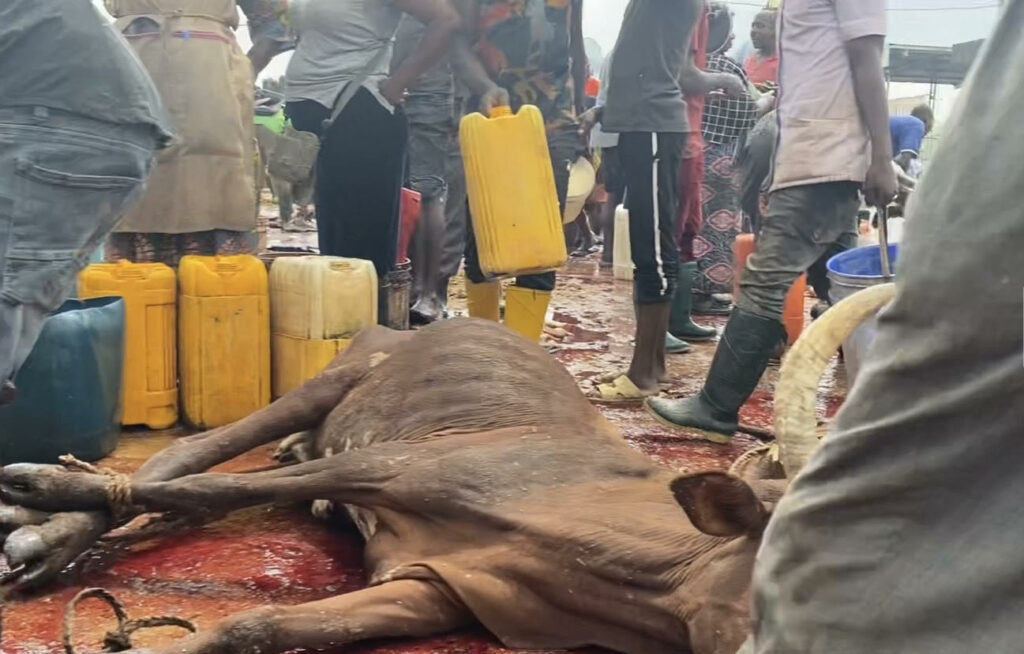
VETERINARY DOCTORS ARE COMPLICIT
In a candid revelation, my new companion acknowledged the deeply ingrained unethical practices within the slaughterhouse but asserted that the blame shouldn’t solely rest on the butchers. He contended that a significant share of responsibility lies with those entrusted to uphold the highest health standards – the veterinary doctors.
SimpleVets outlines the primary tasks of a slaughterhouse vet as hygiene for customer protection and animal welfare. This includes routine inspections and overseeing self-monitoring. However, at the Oko-Oba slaughterhouse, my companion dismissed the idea of the veterinary doctors monitoring the stunning of animals or overseeing animal welfare – a stark deviation from the standard.

In fact, my new friend described them as the “bad people” egging others on to do “bad things”. He claimed that the veterinary doctors have institutionalised a bribery system. He revealed that, for every dead or sick cow butchered, cow owners pay a fee ranging from N5,000 to N7,100 to the veterinary doctors. But gaining direct access to them is futile, as they typically ignore direct approaches. Instead, he said, a certain man known as Alhaji acts as the intermediary, making the unethical business of butchering unfit animals viable.
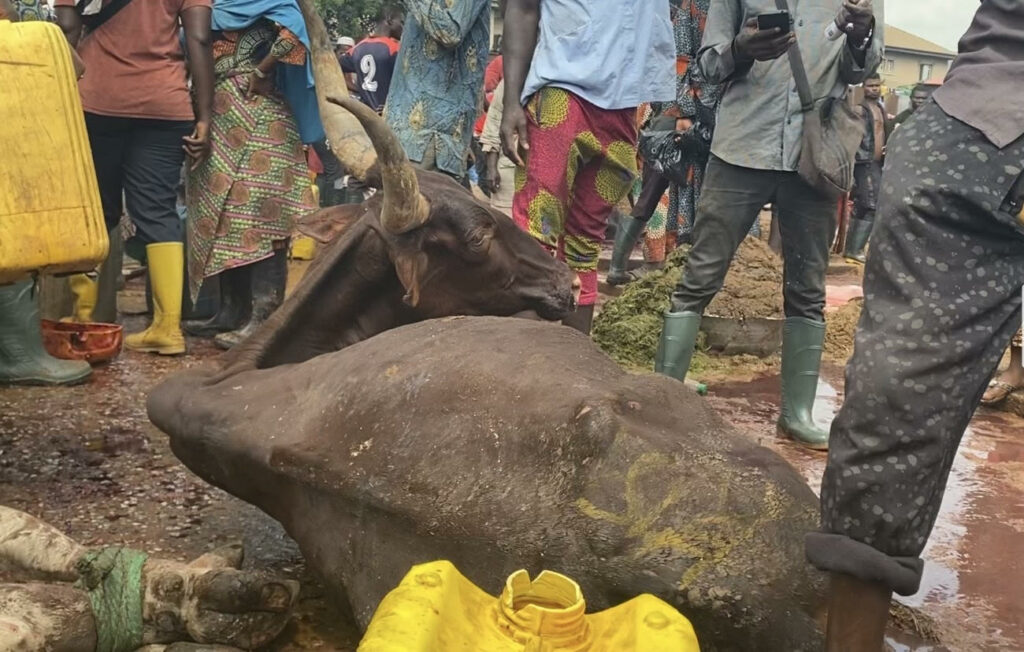
“He’s the one who sells dead and sick animals,” my companion declared, emphasising Alhaji’s role in facilitating the entire process. “If the veterinary doctors do not accept bribes because of him, they would not be doing it. When cow owners realise that their cows are dead, they have to go to Alhaji because, without him, they cannot do anything about it. So, Alhaji and the veterinary doctors are the agents responsible for the illegality in the compound.”
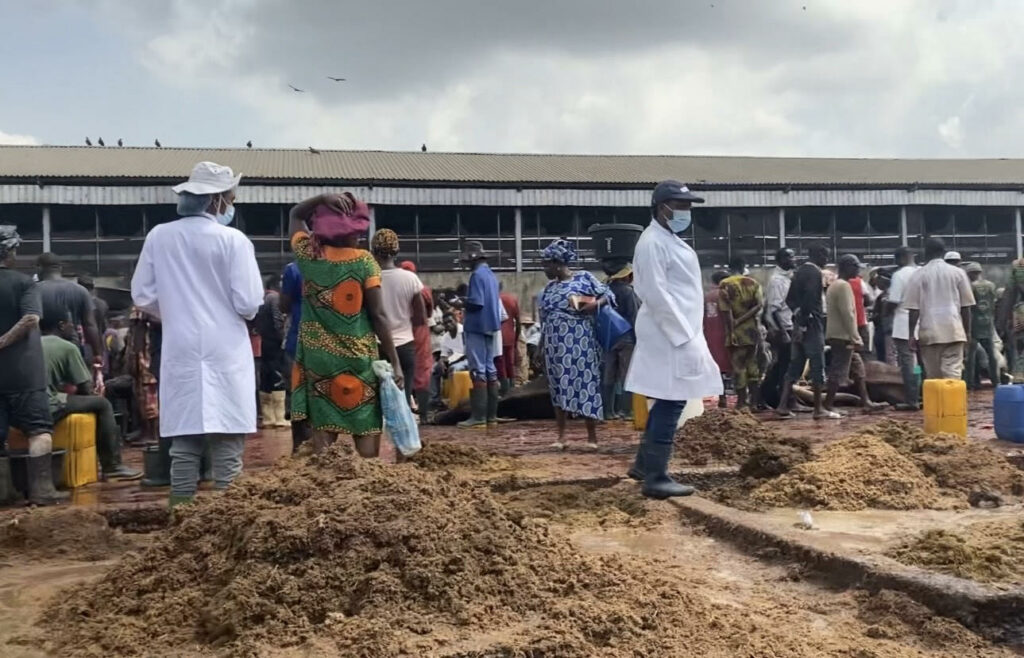
Remarkably, during my three separate visits to the slaughterhouse, I only spotted the veterinary doctors on the last visit, dated November 25. They were clad in long white laboratory coats.
HISTORY REPEATING ITSELF
Ibironke Ademola published in 2010 a research article titled A Restrospective Study of Liver Fluke Disease in Cattle Based on Abattoir Data in Agege, Lagos, Nigeria, in the African Journal of Food, Agriculture, Nutrition, and Development. Conducted between August 1, 2004, and August 31, 2007, the researcher visited the slaughterhouse daily to get firsthand experience of the situation and ascertain the daily incidence of the condition in slaughtered cattle.
Over the three-year period that the study was carried out, a total of 1,170,492 cattle were slaughtered at the abattoir, with monthly slaughter figures ranging between 21,875 and 37,070 over the survey period. The study found that fascioliasis, otherwise known as liver fluke disease, is a fairly common condition in cattle slaughtered at the Oko-Oba slaughterhouse and lairage in Agege, Lagos.
Fascioliasis is a zoonotic disease caused by the trematode Fasciola hepatica that infects a wide variety of mammalian hosts, particularly sheep, goats and cattle. It is transmitted by sheep and cattle to humans the world over.
The researcher recommended a serious, concerted effort to reduce this trend in order to minimise the associated losses so that more liver tissue would not be available for public consumption. But based on media reports after the publication of this research, little seemed to have been done, and with many cows slaughtered without proper tests, unhealthy chunks of meat are delivered to the public.
DEAD ANIMALS, DEATH TRAPS
When animals die, the intricate network that once sustained their tissues, muscles and organs ceases to function. In this void, the growth of germs becomes unabated because the internal regulation that once maintained balance is now absent, thus transforming these microorganisms into a toxic threat. The risk increases significantly when the dead creature remains unrefrigerated or uncooked in the aftermath of its demise.
Furthermore, the consumption of dead or ailing animals serves as a breeding ground for zoonotic diseases, which contributes to the surge in pandemics – a theory substantiated by a 2020 United Nations report. Zoonotic diseases, infections that can leap from non-human animals to humans and vice versa, encompass a spectrum of infectious agents, including bacteria, viruses, parasites, or prions. Notable instances like the Ebola virus disease and salmonellosis exemplify the zoonotic origin of major modern maladies.
According to a 2017 paper, approximately 60 percent of known infectious diseases and up to 75 percent of emerging infectious diseases have a zoonotic genesis. The toll is staggering, with an estimated 2.5 billion cases of human illness and 2.7 million human deaths attributed to zoonoses worldwide each year.
EFFECT OF THE ABATTOIR’S ANOMALIES ON PUBLIC HEALTH
Mustapha Iskil, a biochemist and animal documentarian, says that it is extremely important to test animals before killing them to safeguard public health, as certain diseases can be transmitted to humans through the consumption of these animals.
Iskil points out a troubling trend where some individuals, posing as experts, misuse antibiotics in treating cattle, leading to the development of antibiotic resistance in the animals. He said that when humans consume such antibiotic-resistant animals, they inherit the bacterial strains and this a serious health risk.
Temitope Olaogun, a veterinarian with experience in slaughterhouses, said that the pervasive lack of adherence to proper procedures in the country sometimes complicates situations in slaughterhouses. Olaogun explained that some veterinarians who, fearing adverse reactions from cattle owners, may hesitate to condemn unfit animals repeatedly without compensating the owners even when necessary.

He notes that inadequate equipment in many slaughterhouses further impedes veterinarians in conducting essential tests for residue limits and identifying pregnant animals.
To address these challenges, Olaogun proposed government intervention, including the provision of necessary testing equipment, increased employment of veterinarians and the enforcement of health policies. He emphasised the need for the creation of semi-mechanised abattoirs and the abolition of traditional slaughter slabs for a more regulated and hygienic system.
GOVERNMENT’S LACK OF COMPENSATION PROMOTES UNETHICAL BEHAVIOUR AMONG CATTLE OWNERS
Olaogun highlighted that in certain states, veterinary doctors may be hesitant to adhere to ethical inspection procedures due to the absence of financial compensation from government authorities to livestock owners who may have incurred financial losses.
According to him, the presence of this problem empowers the human weaknesses of the cattle owners, who are victims of a dysfunctional system, to prioritise wealth making over the general welfare of the people.
In the United States, the United States Department of Agriculture (USDA) offers various Disaster Assistance Programs (DAP) designed to assist farmers, ranchers, communities and businesses affected by natural disasters. Two of these programmes are the Livestock Forage Disaster Program (LFP) and the Livestock Indemnity Program (LIP).
The LFP provides compensation to eligible livestock producers who have suffered grazing losses due to drought or fire on land that is native or improved pastureland with permanent vegetative cover or that is planted specifically for grazing, while the LIP provides benefits to livestock producers for livestock deaths in excess of normal mortality caused by adverse weather or by attacks by animals reintroduced into the wild by the federal government.
In Canada, the Canadian Food Inspection Agency (CFIA) manages compensation programs for livestock owners. Similar to the United States, compensation is provided to owners who must cull their animals due to disease control measures. For animals ordered destroyed, the CFIA bases compensation amounts on the animal’s market value at the time of the order for destruction, up to a maximum amount as stipulated in the Compensation for Destroyed Animals Regulations. At the time of evaluation, the CFIA will take into account all available market reports and supporting documents in order to reach a final market value.
In the United Kingdom, the Department for Environment, Food & Rural Affairs (DEFRA) administers compensation schemes for livestock owners. Compensation is provided for animals that undergo slaughter as part of disease control measures, particularly in cases of diseases such as bovine tuberculosis. Typically, livestock owners are eligible for compensation not only for healthy animals culled but also for those affected by the specified disease in question.
NO RESPONSE FROM LAGOS STATE GOVERNMENT
Three of the five core values boldly written on agriculture.lagosstate.gov.ng are responsiveness, integrity and accountability, but these have not been followed to the letter. On December 1, FIJ sent an email to the Lagos State Government for comments about the happenings at its biggest slaughterhouse, but they had not responded at press time.
This story was produced with support from the Wole Soyinka Centre for Investigative Journalism (WSCIJ) under the Collaborative Media Engagement for Development Inclusivity and Accountability project (CMEDIA) funded by the MacArthur Foundation
Subscribe
Be the first to receive special investigative reports and features in your inbox.


